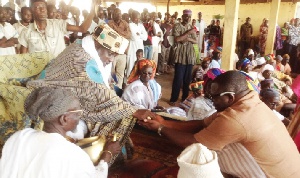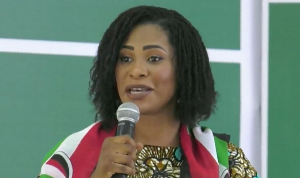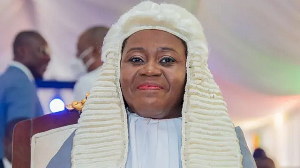Gushegu is one of the key traditional towns of the Dagbon kingdom located in the eastern part of Dagbon with Naa Y?b' Gushe-naa as its traditional head.
This town which was originally called BO?LINI before the arrival of Naa Yeb' Gushe-naa there, is one of the ancient communities of pre- Dagbon, i.e the origin of which, predates the ARRIVAL of Naa Shitobu, the founder of Dagbon kingdom in Ba?li - the very first hamlet where Shitobu & his followers settled to found the current Dagbon. Simply put, the place was one of the settlements that the descendants of Shitobu annexed through conquest at the inception of Dagbon and can not be said to be a place that started LATER out of Karaga & Kpatinga land in the era of Naa Zoligu (the 5th Ya-naa from Nyagsi ) who ruled Dagbon from 1469 to1486, as some people want us to believe.
It is instructive at this point, to point it out that when Dagbon kingdom began to take its current shape in 1416, precisely, under Naa Nyagsi, i.e the immediate successor and first son ( Zuu) of Naa Shitobu, Naa Yeb' Gushe-naa, just like Naa Nyagsi and other elders of Gbewaa (i.e the grandfather of Nyagsi) first settled in Western Dagbon known in vernacular as T?mo. Gushe-naa precisely settled at a place around Kasuli Warivi now known as Gushegu - Dabari. I hope you remember Yani - Dabari too?
All that while, the chieftaincy title for this modern Gushegu was "Boglinaa" coined from the name of the place "Bo?lini" as opined earlier.
Evidentially, till date, that chieftaincy title still exists in the Gushegu traditional area. Why and How?
I think it's a common history that the kingdom of Dagbon never started with its current traditional capital i.e Yendi as the seat of the overlord of Dagbon ( Ndan Ya-naa).Ya-naa was at Yani-Dabari. It was the eventual relocation of Ndan Ya-naa to eastern Dagbon in Yendi that occasioned the relocation of Naa y?b' Gushe-Naa too from Gushegu Dabari to Bo?lini ( i.e his current place ). That was the era of Naa Titugri around 1570 to 1589.
Boglini becomes Gushegu. How?
When Ndan Ya-naa Titugri in around 1571, relocated from Yani - Dabari in the western Dagbon to his current location in Yendi, some of the senior-most elders of Dagbon ( Yo?u Kpamba) comprising Gushe-naa, Gulkpe-naa, Tugurinam who, once upon a time, together with Naa Gbewaa migrated from the kingdom of Biun in Fardan-Gurmah to Pusiga in the pre-Dagbon era and whose roles in the scheme of affairs of Dagbon are very "technical" in nature, in much the same way, saw the need to join Naa Titugri in eastern Dagbon so that the proximity that is much needed amongst them as it was in the days of Gbewaa in Pusiga through Shitobu in Ba?li, to Naa Luro in Yani- Dabari wouldn't be lost.
On the basis of this, history has it that when Naa Titugri enskinned TAGNAMDI who was then in Mali?eri, as the new Gushe-naa at the time, after the death of Gushe-naa Kukpirigu in Gushegu-Dabari at around Kasuli Warivi, it was UNANIMOUSLY decided that instead of taking the title to settle at Gushegu - Dabari, Tagnamdi should permanently settle at Bo?lini, some 36 miles away from Yendi which was then under the tutelage of N y?b' Boglinaa as "tindana".
So to pave way for Tagnamdi to occupy Bogilini, Ndan Ya-naa Titugri sent a message to Bo?linaa to relocate. A request, Boglinaa instantly yielded to and moved to a new settlement, north-east of Gushegu around a relatively popular community called PUMO. This Boglinaa's new settlement was renamed Bogilinaayili and has since been so.
Evidentially speaking, till date, that community still exists with the relocated Boglinaa, who now draws his authority from Gushe-naa as its chief. The current Boglinaa is, however, ruling from Pulo for reasons not worth bringing here.
Another information of evidential value relative to this historical account is the fact that, to PRESERVE THIS HISTORICAL FACT THAT GUSHEGU WAS AN EXISTING COMMUNITY ALREADY OWNED BY SOMEBODY (TINDANA) BEFORE IT WAS TAKEN OVER FROM him by Gushe- naa and Ya-naa, in this case, Boglinaa, anytime a newly enskinned chief of Gushegu is arriving home from Yani, the Boglinaa and other tindaanba (owners of land) like Yiborinaa will meet and stop him at the outskirts of Gushegu pretending they will not allow him entry. While still sitting on the horse, Gushe-naa with all humility pleads with them. But they won't understand him until he assures them that he is not coming to rule them but to farm with them to ensure an abundance of food in that enclave. And to convince them more, while still on his horse, he shows them a hoe and a cutlass before they allow him entry into Maltimayili.
WHO IS TAGNAMDI? This great chief of Gushegu who made history as the first Gushe-naa to settle in Gushegu's current location and whose grave is now one of the shrines in Gushegu was born out of inter-marriage between the first daughter (Pakpa?) of Naa Nyagsi & an elderly Moshi man in Mal?eri. So from the look of things, Tagnamdi was "pa?bia" who was born and bred in Mal?eri. It is equally worth mentioning that until after Tagnamdi picked the "cola" for Gushegu, he lived all his life in Mal?eri.
I must also add that when the issue of the relocation of Gushe-naa came up during his historic enskinment, because of Tagnamdi's roots in Mal?eri, he first opted for that place. But upon further consultation, Bo?lini was deemed more appropriate. Have you ever asked yourself these questions?
1.Why is it part of the Dagbon tradition for every newly enskinned Gushe-naa, on his journey back to Gushegu from Yani makes a brief stop at Mal?eri to bid Mal?eri lana and his people farewell.?
2. Why is it that anytime Gushe-naa has a role to play in Yendi that demands that he stays there for even a day, by custom and tradition, he won't sleep there but will rather go and pass the night at Mal?eri?
It was all started by Tagnamdi and is being preserved through these customary practices to always BEAR A CLEAR TESTIMONY to this historical account I have given above regarding TAGNAMDI.
From the account so far, I think it is empirically clear to every reader that Gushegu is one of the ancient communities of pre-Dagbon and therefore will be a figment of anybody's imagination to claim that it only came into being during Naa Zoligu.
It's also clear that the very first Gushe-naa to settle in modern Gushegu was Naa Tagnamdi from Mal?eri near Yendi but not Danbori. Admittedly, Danbori is one of the past chiefs of Gushegu but has no links whatsoever to what a particular Facebook page administrator (with a large following) claims to be the CIRCUMSTANCES UNDER WHICH HE ASCENDED THE GUSHEGU SKIN. That assertion, with due apology, is nothing but what can best be described as an invented history of convenience.
That said, I will want to continue by furnishing you with the names of the past chiefs who occupied the Gushegu skin at Gushegu-Dabari before Tagnamdi took it to its current location. This is important because that can also deal effectively with the mischief which is in circulation that it was Danbori who started the Gushegu namship.
They are five in number :
1. Naa Shiwoo - he is said to have been the pioneer chief at Gushegu-Dabari and by extension, the first Gushe-naa to have had his own land in the newly established kingdom of Dagbon like his great grandfather in Biun.
That explains why "shiwooyili" is one of the appellations or names of modern Gushegu.
The rest of them are Gbanzogu, Sheblandi, Daanbori and Kukpirigu. In all, from the time of Nyagsi, unlike the Yani skin which has produced thirty-seven (37) occupants so far, Gushegu skin has had as many as thirty-four (34) occupants i.e 5 at Dabari and 29 so far at the current location with Naa Tagnamdi as the pioneer chief there.
With this number of past chiefs at Gushegu-Dabari, what I believe will now be agitating the minds of many readers was the fate of the descendants of these past chiefs now left at Dabari after Tagnamdi of Mali?eri origin relocated to current Gushegu with the skin. There is a lot of information on this. But I will want to make a long story short by telling you that the regent of the last chief at Dabari who by all intent and purposes, was hoping to succeed his father had to be placated with a new title by name KASULI-LANA which literally means, a chief who lacks anger. It was all because of the maturity he exhibited at the Gbewaa palace by not showing any sign of anger at the turn of events. And you know what? When the regent and his entourage got back home at Dabari, in order that Dagbon didn't end up having two Gushegus as we have in the case of some of the communities now, they thought it wise to build his palace at a new settlement different from the original one (now called Gushegu - Dabari) and named it KASULIYILI with the chieftaincy title KASULILANA as indicated earlier hence, today's Kasuliyili. However, immediately after the death of Tagnamdi, one of the descendants of the past chiefs ( Dabu?lan' nima) at Kasuliyili i.e Gushe-naa Mahami Kpema was enskinned to succeed Tagnamdi at Gushegu.
The current traditional happenings that lend credence & testimony to this historical account about Kasuliyili and Gushegu namship is the fact that till date, N Yeb' Kasuli- Lana shares with Naa Yeb' Gushe-naa MOST appellations. Or you think it's for nothing that our griots (baansi) as part of their praise songs to Kasuli Lana "raps" him with phrases like Sheblandi Zuu, Kukpirigu Dabu?' lana, Daanborinaa & many others which are equally done to Naa Yeb' Gushe-naa by his griots? They both share common ancestry in those past chiefs (Dabu?lan nima)!!
So wherein lies the basis of the "Danbori story" that was fabricated on this media to distort our history? I want to believe that those guys were found in a situation to give out what they literally did not have.
What about the origin of Gushegu's name & the title Gushe- Naa?
The title Gushe-naa, is as old as the ancient chieftainship (Nam) that was inherited by Gbewaa from Kpu?numbu (his biological father) and which we have transmogrified and are now practising today.
It's a matter of historical fact that the Nam we are using today is from the people of Biun in Fadan Gurmah (in today Burkina Faso) which was taken over by Kpu?numbu, the father of Gbewaa. So upon the death of Kpu?numbu, Gbewaa succeeded him but decided to relocate to Pusiga. When Gbewaa was migrating to Pusiga he was lucky to have been followed there by some of the indigenous chieftaincy titleholders like Gushe-naa, Gulkpe-naa, Tugrinam, who already had distinct traditional roles in the namship of Biun even before the takeover of the namship by Gbewaa and his father. By this narration, it is clear that the Gushe-naa is MORE OR LESS ONE OF THE FOUNDING ELDERS OF GBEWAA NAM. So he was within the inner circles of Gbewaa in the right sense of the phrase.
The origin of the title, "Gushe-naa" has its roots in Fardan Gurmah. History has it that the word "Gushe?u" is a name of a place at Biun. But some people contend that it is now a shrine. I am however, still cross checking & double cross checking to know which is which. So the elder who had the traditional authority over that place then, and who was more or less, a fetish priest and had the exclusive traditional role of selecting the "tindaanba" at Biun now changed to "Nanima" by Gbewaa was given and known by the title, Gushe-naa by Naa Gbewaa.Thus, coined from the name "Gushe?u".
So in Shitobu Dagbon, where the Gushe-naa settles is named Gushegu just like in the case of his counterpart, Gulkpe- naa whose place of settlement also assumes the name, "Gulkpegu". In short, we brought those names from Biun. I hope you remember the Yani-Gukpegu too when N Yeb' Gulkpe-naa tried relocating to eastern Dagbon some time back !
So all in all, Bo?lini came to now known as Gushegu because the title Gushe-naa & the skin were taken there by Tagnamdi.
THE ROLE OF GUSHE-NAA IN GBEWAA ERA
Now that we've come far with the history of Gushegu and its chieftainship, let's have a look at the standing of the Gushegu skin in the scheme of affairs of Dagbon.
The Gushe-naa was not only a SENIOR MOST ELDER at the time of Gbewaa but was also a rich repository of the CUSTOM, TRADITION & CULTURE regarding the "nam" of the people of Biun - the matrilineal lineage of Gbewaa.
Remember, in the previous episodes, I posited copiously that this modern chieftaincy (nam) of Dagombas has its origin in Biun but came to be part and parcel of Dagbon tradition through its usurpation by Kpugnumbu, the father of Gbewaa.
So Gushe-naa, being one of the founding elders of the modern Dagbon namship and who was already having his own well-organised band composed of trumpets and drums, was more or less a resource person to Naa Gbewaa in Pusiga regarding the "new" chieftainship. It's quite instructive to add that unlike the then Gushe-naa, Gbawaa had not griots (baansi) at that time. On the back of all of this, your guess is as good as mine what the role of Gushe-naa's band was. Among other things, they were keeping the track record of the evolving custom ( Kalli). That explains why throughout Dagbon, the Gushe-naa is the only chief, in addition to his substantive title, uses the additional title "KALINAA"/ KAYANAA". It all started in the days of Gbewaa. I must add that, that appellation is his EXCLUSIVE PRESERVE in Dagbon.
Throwing more light on Gushe-naa's historic band, the band is composed of high note trumpets known in Dagbani as "yuya" and relatively larger trumpets with a low note, known in Dagbani as lug-nyini. The third instrument is a special small drum known in Dagbani as Gbungbul' Lu?a.
History has it that when one of the sons of Gbewaa by name Zirli "murdered" his brother, Fogu because of succession related rivalry, and the elders sensing that it wasn't an easy task informing Gbewaa about that sad incident through ordinary conversation, it was Gushe-naa, in his wisdom as the SENIOR ELDER who used this band of his to relay that sad news to Gbewaa. He went to Gbewaa in the company of the band who played their instruments announcing the incident to Gbewaa in a sorrowful beat with the lyrics in Dagbani as: "Zirli Ku Fogu", Hmmm! ? shiri Ku ya", M baye! M ba ye! Hmmmm! O shiri kuya". Literally means; "Zirli has killed Fogu, he has actually killed him".
For those who don't know, this is one of the very important ingredients of the history of Dagbon. And You know what! Throughout Dagbon, it's only Naa Yeb' Gushe-naa who by custom, had the exclusive right to commemorate that incident. His griots including the ancient ones he brought from Biun commemorate it at his palace in the night on the eve of every Dagbon festivals like fire festival, the Eid festivals etc. In fact, that's his version of Samban lu?a which is usually organised at Gbewaa palace and the palaces of the other divisional chiefs on such occasions. It is called TINKURISILI. I remember I wrote on this topic briefly, last year when this current Naa yeb' Gushe-naa commemorated his first Tinkurisili.
So in Dagbon, it's only Gushe-naa who plays Tinkurisili and the sound of the playing instruments on that occasion depicts nothing else but "Zirli Ku fogu".
So if you are a Dagomba by tribe and you actually believe that this history of ours about "Zirli ku Fogu" occurred only in the days of Gbewaa and there is also this clear and undisputable LINKAGE of Gushe-naa to it, why do you expect people to take you seriously if you argue preposterously that Gushegu & its Skin only came into being during Naa Zoligu who is even the 5th Ya-naa? What fallacy !!
In Dagbon tradition, there are a lot of customary practices that undisputedly give us a clue as to the high standing of the Gushegu skin. Come to think of this:
1. Why is it that the Gushe-naa uses the same collection of skins as Ya-naa does? In Dagbon, it is only the two of them who use an Lion's and a tiger's skin as part of their seating skins.
2. Do you also know that the same procedure is adopted by our custom, in burying Naa yeb' Gushe-naa on his demise as it is in the case of Ndan Ya-naa? They bury each of them with the skins of a lion and that of a tiger.
3. As part of the performance of the funeral rites of Naa yeb' Gushe-naa, a handful of thatch is removed from the main hall of the palace (known in vernacular as Mo?u ?oobu), signifying the removal of the traditional authority from the palace of the deceased chief as it is done during the funeral rites of Ndan Ya-naa.
These are exclusive rights to the two of them.
4. Amongst Dagbon chiefs, it's only Naa Yeb' Gushe-Naa & Ndan Ya-naa who are entitled to a sub-chief by title "Kalibil' lana. I bring this to buttress the point mentioned earlier that Gushe-naa is Dagbon KALINAA/KALILANA. However, there are some of his roles as kalilana that by virtue of his position, he doesn't perform himself. So he appoints his kalbil' lana ( i.e small Kalilana) to represent him on such occasions.
At this juncture, I bring the "Malitima yili" series to an end this evening with a strong belief that BASELESS PROPAGANDA about the Gushegu skin has been effectively dealt with. I equally trust that your minds have been disabused of that misinformation.
Opinions of Wednesday, 14 October 2020
Columnist: Mutawakil Tahidu















